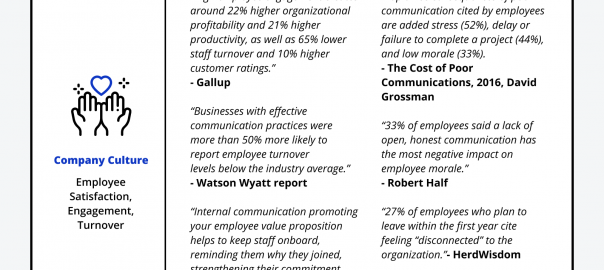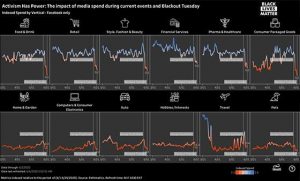Despite investing heavily in digital solutions at the start of the pandemic, many business leaders are seeing productivity losses within their organizations. With economies around the world re-opening, they are now looking at the future shape of their workforces.
The downward productivity trend after initial gains at the start of the pandemic is a common story. However, a few companies are seeing progress — specifically, those successful at managing employee time, talent, and energy before Covid-19. These businesses excel at continued growth, outpacing the rest by 40% in an ever-widening corporate productivity gap.
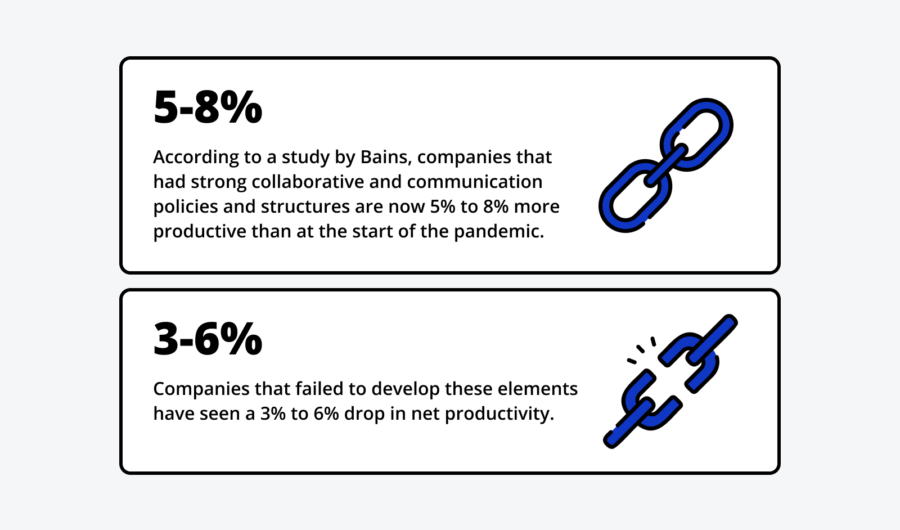
This parallels what happened after the 2008 financial crisis and seems to be following a similar trajectory of over-optimism mixed with lagging policies, broadening organizational cracks before an eventual and expensive return to a pre-crisis status quo for many organizations.
Let’s start by looking at how the current Covid-19 crisis shifted business priorities and advanced digital roadmaps more in a few weeks than they had moved in the last decade.
Responding to a Crisis
Changing Priorities
The pandemic shifted the priorities of many companies. It created supply chain delays and roadblocks to customer interactions, worker productivity, and collaborations. Worse, it also caused massive hits to organizational stability and overall revenue.
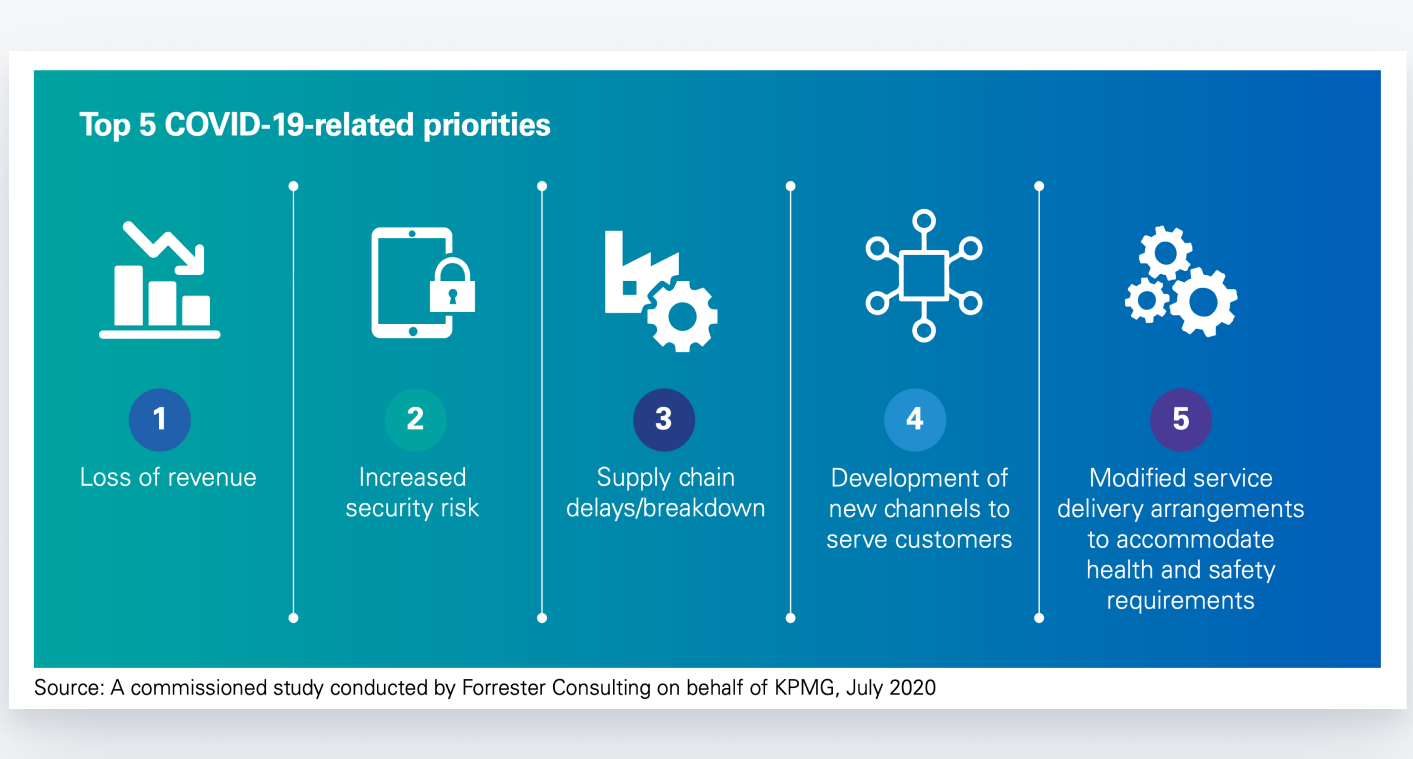
KPMGs’ Going Digital, Faster, Global survey into the impact of COVID-19 on digital transformation (Hernandez-Kakol, Hernandez, Clamp 2021)
With government mandates limiting and eventually closing businesses and shopping centers, many companies followed, suit with many closing their doors for good.
To avoid falling revenue and supply chain stalls and to create longer-term stability, many companies accelerated their investments into new technologies.
According to a 2020 McKinsey Survey, eight weeks after the start of the pandemic, several companies with sizeable skilled labor forces jumped ahead five years in consumer and business digital adoption.
With many employees working from home, collaboration efforts were heavily impacted. As a result, businesses saw the biggest push to digitize. So hard was this push that it advanced by six years in just a few weeks.
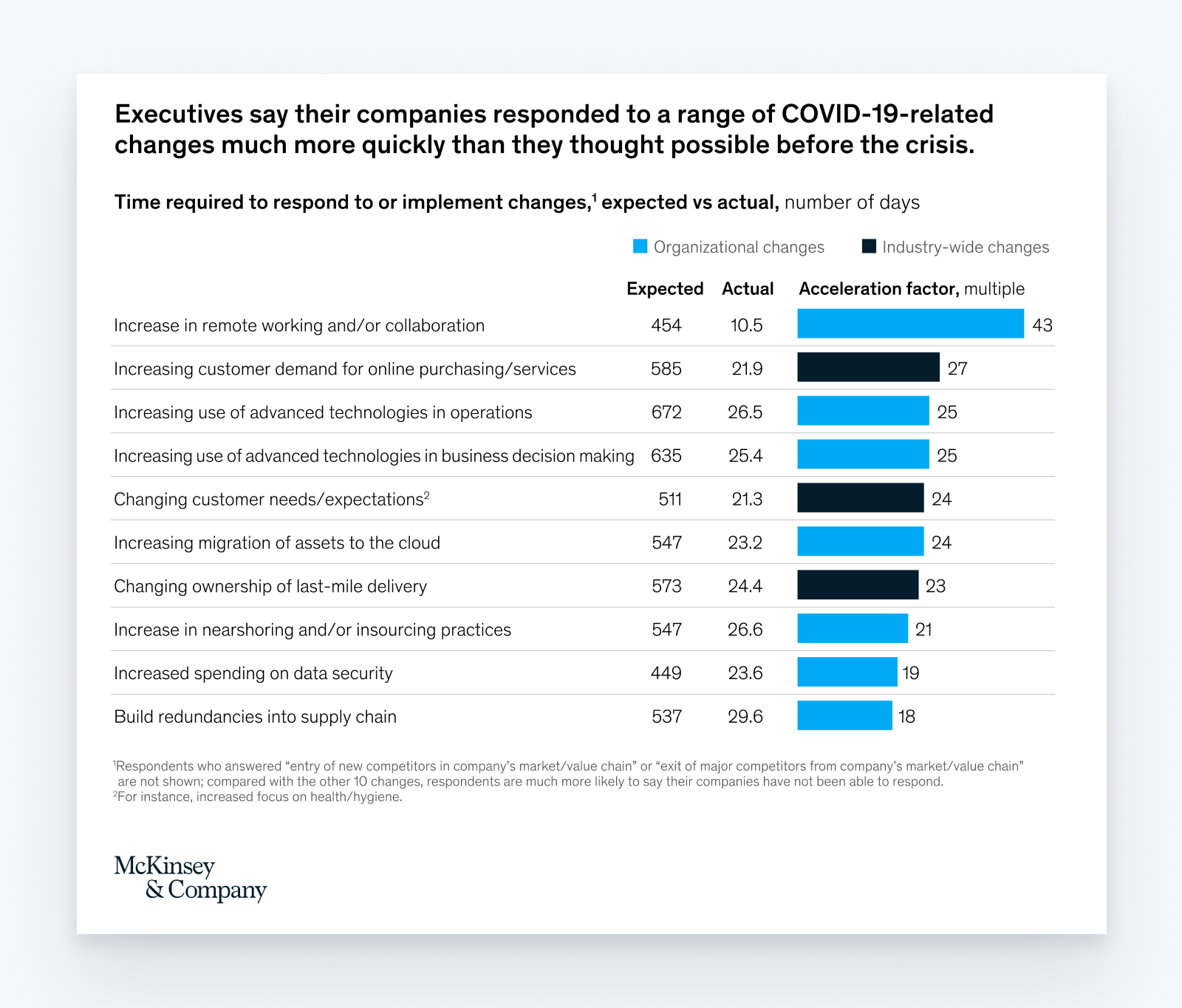
McKinsey & Company’s, How COVID-19 has pushed companies over the technology tipping—and transformed business forever (Laberge, O’Toole, Schneider, Smaje 2020)
How Companies Transitioned Their Communications and Collaboration Online – Survey
In April 2021, Mailbird submitted a survey through HARO asking C-level executives (83%), IT professionals (2%), and senior managers (15%) about their transition to a fully remote or hybrid workforce model.
- Most respondents had their employees working entirely in-office prior to the pandemic (53%)
- Some had their staff WFH some of the time (32%).
- Only 13% had fully remote staff.
Most respondents said their companies adopted new software and/or tools for digital communication and collaboration (84%). Of this group, a little over two-thirds (68%) faced unexpected challenges making the transition, although the vast majority did say it met their expectations (97%).
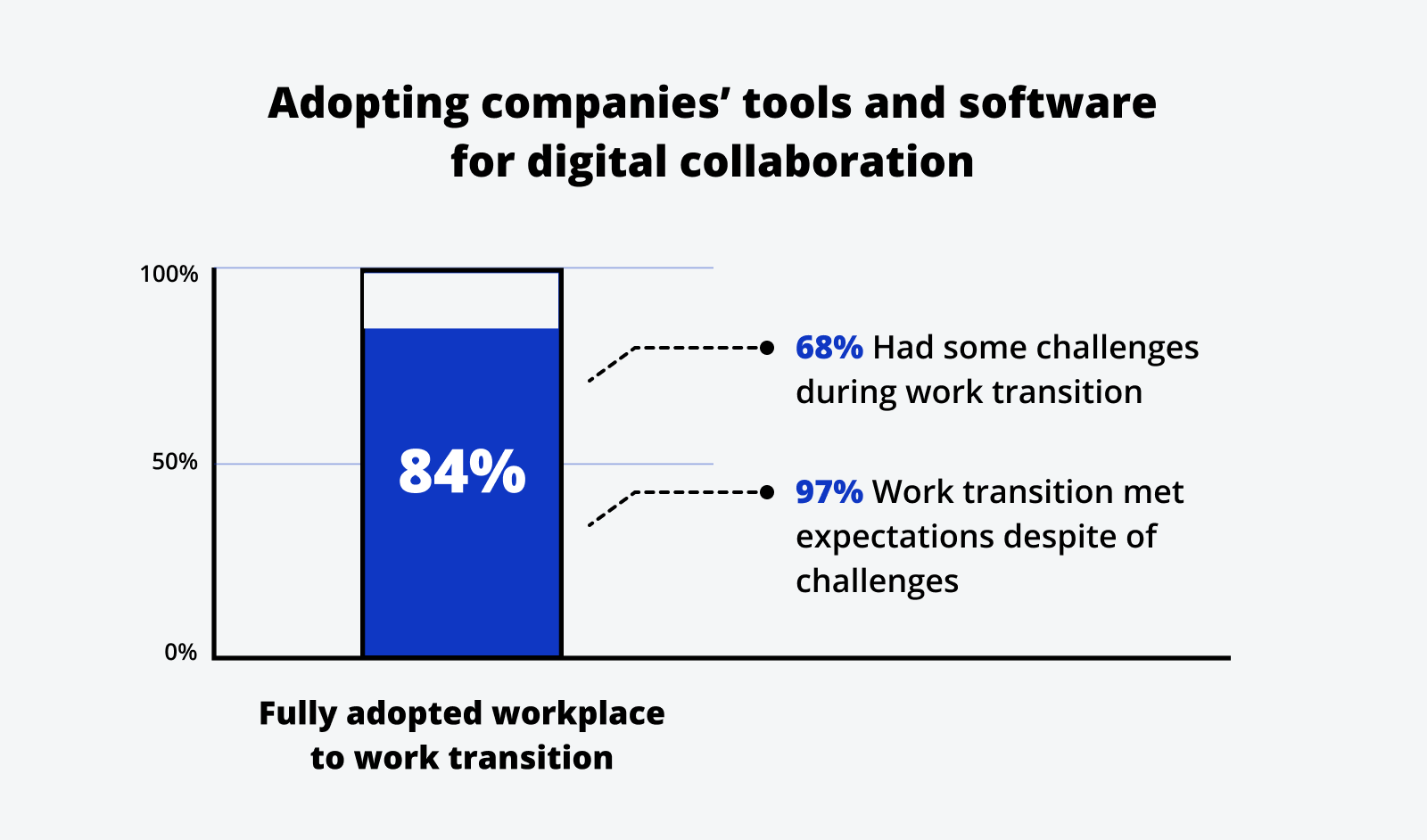
The most common issues encountered for previously 100% in-office respondents:
- Increased cost – going from “free” collaboration methods to having to pay for apps.
- Learning hurdles – Having to train staff on the proper use of the new apps and creating learning materials.
“The learning curve was difficult for many who had never used web-based applications and cloud storage. To help train everyone, I presented and recorded customized training videos for our staff to be able to reference from home.”
– Nina Womeldurf, Director of Marketing and Communications for the Tampa Museum of Art
“The switch from whiteboards and post-its to Asana was rather difficult. It took weeks for our team to start really making use of Asana’s features. We just weren’t used to using a digital tool for communication in this regard, and it really took people a while to get used to it.”
– John Ross, President and CEO of Test Prep Insight
- Adapting to new security risks – Employees not using secure networks.
- Lack of personalization – For companies that require face-to-face interactions with customers, this is ultimately a trade-off for a wider talent pool and other benefits that come via apps.
“Because we’re a law firm, lack of personalization that would originally come from office consultation and courtroom litigation could lead to poor connection and less impact. However, through a hybrid setting, we can in fact see advantages such as widening our talent pool and growing our base.”
– John Berry, CEO of Berry Law
- Creating information silos – Critical information isn’t shared between departments which results in duplication of effort, lack of synergy and missed opportunities.
“The thing we struggled with the most was internal communication, even with the tools in place it took time to adapt and make sure lines of communication in the business were maintained. It’s very easy in that situation for silos to develop and decisions get made based on those limited and fragmented comms that aren’t always the correct thing to do.”
– Matthew Gribben, CTO of Farmison & Co
- Leadership challenges – Extroverted more hands-on leaders need to balance constraint and how they manage others.
“Remote leadership has been challenging. I’m someone who thrives on the energy of the people around me and depends on physical cues like body language to understand how people are doing and feeling. During this time, it’s been key to not overwhelm them with communication and pace and tailor our feedback based on the personality of the teammate. Finding ways to let them know that we’re in this together and they’re not on an island can be really helpful.”
– Abhi Lokesh, CEO and Founder of Fracture
- Having to dedicate resources towards creating new remote-work policies.
- Ensuring all employees have the necessary home setups to use the new tools.
Of the respondents who said they had no issues onboarding the new technology (33%), most were web-based companies (75%) with the one exception already having 60% of their workforces working remotely prior to the pandemic.
These respondents said that having robust and management-led communication policies is essential for a smooth transition:
“As far as it is convenient and according to our calculations, the costs of using these applications turned out to be relatively small. Good communication depends a lot on managers. Therefore, it is essential that company leaders, and then heads of departments, establish a simple, convenient, and transparent way of employees’ interaction.”
– Andriy Bogdanov, CEO, and Founder of OnlineDivorce
Takeaways
- Most businesses had to switch to working remotely.
- In almost every case, the capabilities of the technology-enhanced communication and collaborative potential.
- The negative impact of the switch mostly involved getting everyone up to speed on how to use the new software/tools. However, some businesses (ones dependent on in-person interaction) have faced additional challenges.
Those with the least or no issues had management-led communication policies and strategies in place prior to the pandemic.
Moving the Meetings to Zoom
Every industry had to adopt some new technologies to allow their employees to collaborate, interact, and communicate with each other and their customers.
Even manufacturing managed to make the switch.
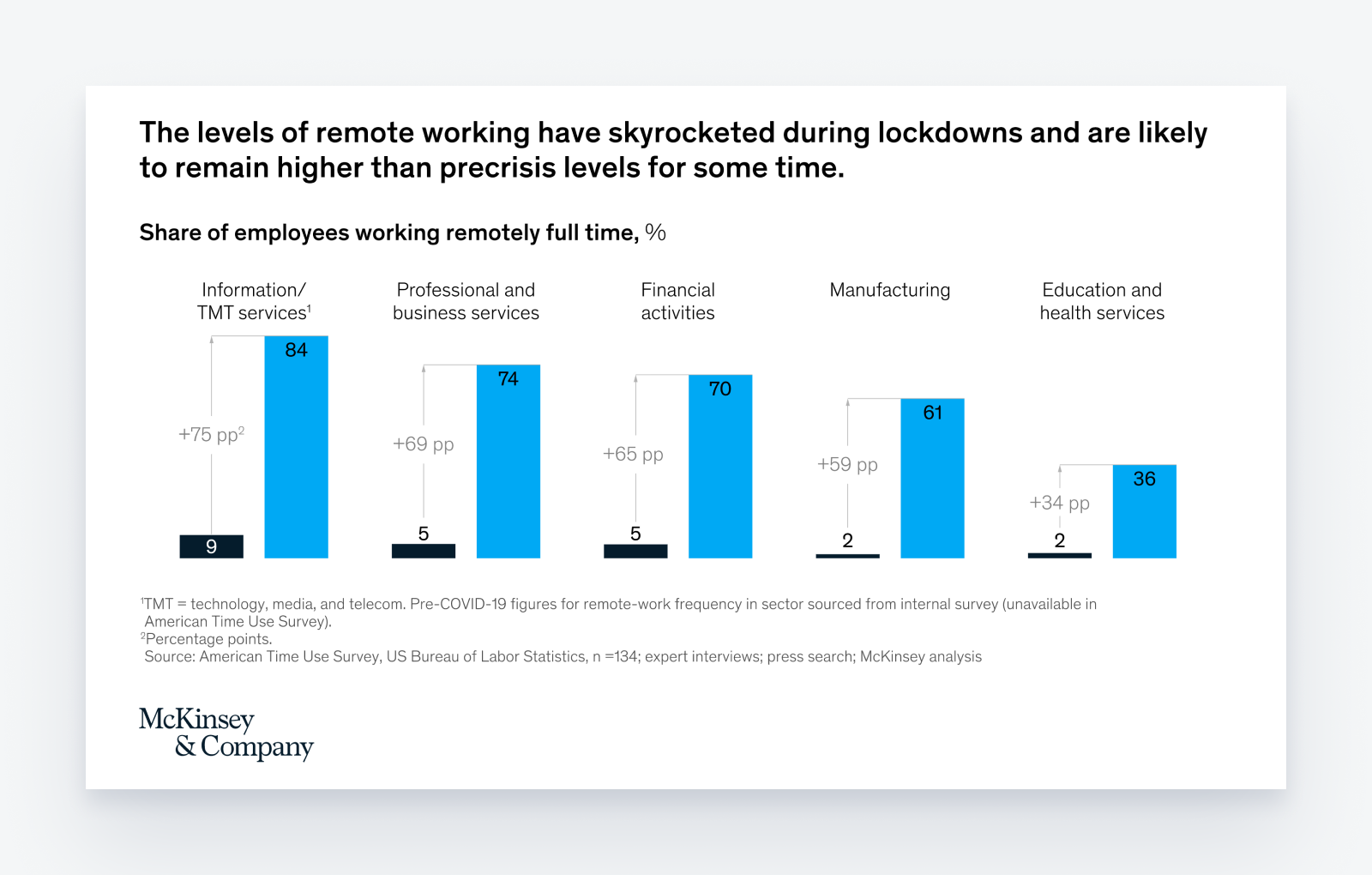
McKinsey Digital’s The COVID-19 recovery will be digital: A plan for the first 90 days (Baig, Hall, et al. 2020)
The speed of the move to online work led to a lot of optimism from business leaders and industry publications. They felt that, with the barriers to digitization overcome and productivity increasing between 10% and 47% in a single year, it was a clear win for tech adoption. However, the feelings of success were not shared by everyone.
Employee Burnout Becomes a Global Problem
Remote workers have always been more susceptible to burnout compared to their in-office counterparts. Generally, this has been due to factors such as trouble communicating efficiently, lack of accountability, a sense of isolation, and a chaotic home-office environment.
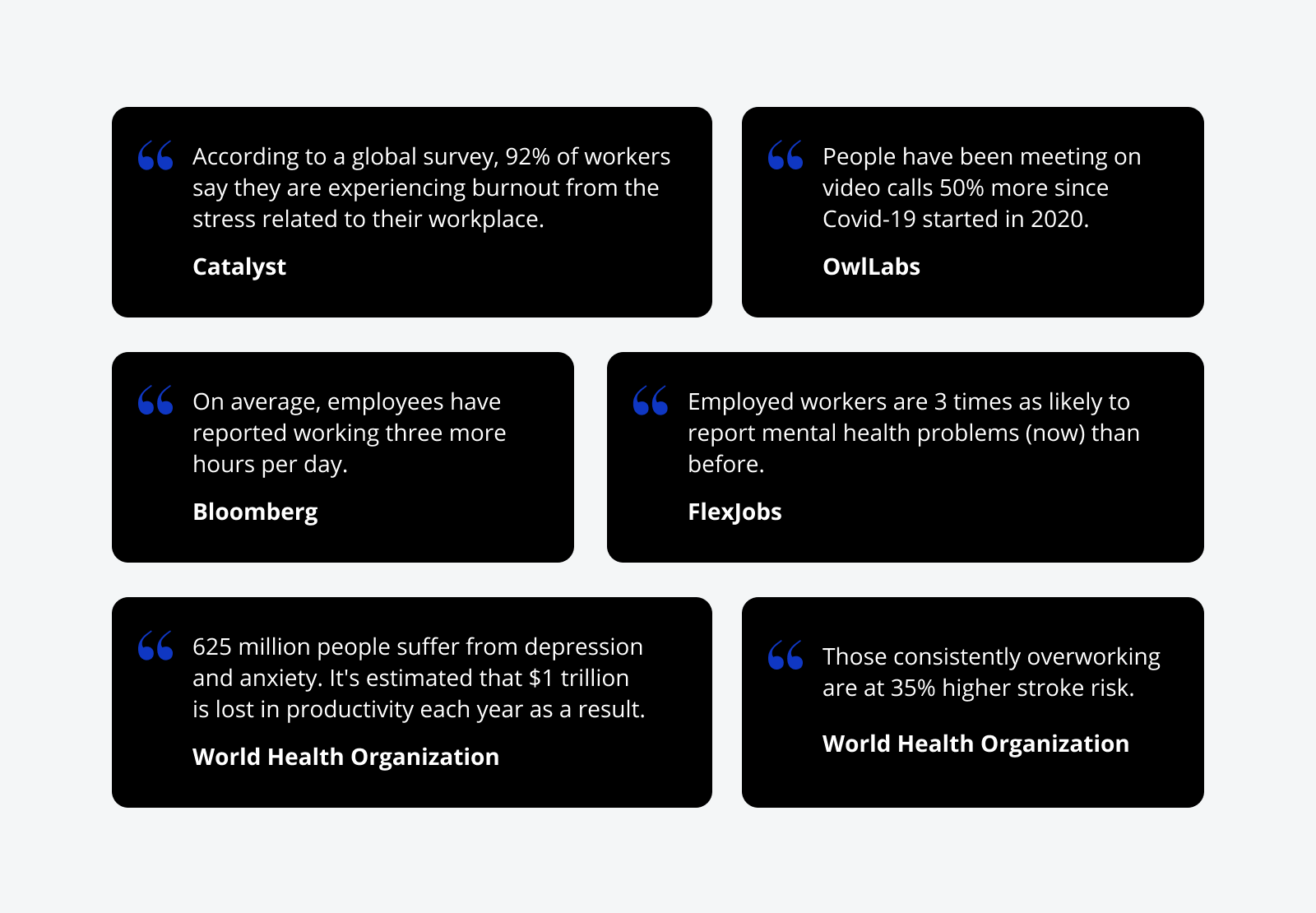
Rather than plan for these roadblocks, many employees were pushed into working remotely with little preparation or guidance from their employers. Many teams had to balance meeting work expectations with learning how to be productive at home. This led to a gradual ballooning of meetings, emails, and overall work time that wasn’t counted towards working hours.
In Canada, the extra time remote employees were putting in to meet work expectations is being called the “COVID Tax.” A survey from ADP Canada and Angus Reid found that:
- While this “tax” impacts 30% of all employed Canadians surveyed, it is significantly higher for remote workers and has increased over the pandemic.
- Nearly half (44%) of remote workers say they are logging more hours than pre-pandemic times. This figure has doubled over the past year (21% in April 2020 vs. 44% in May 2021).
- Of the 44% of respondents reporting working longer hours, one in ten said working an additional day or more (8+ hours) per week.
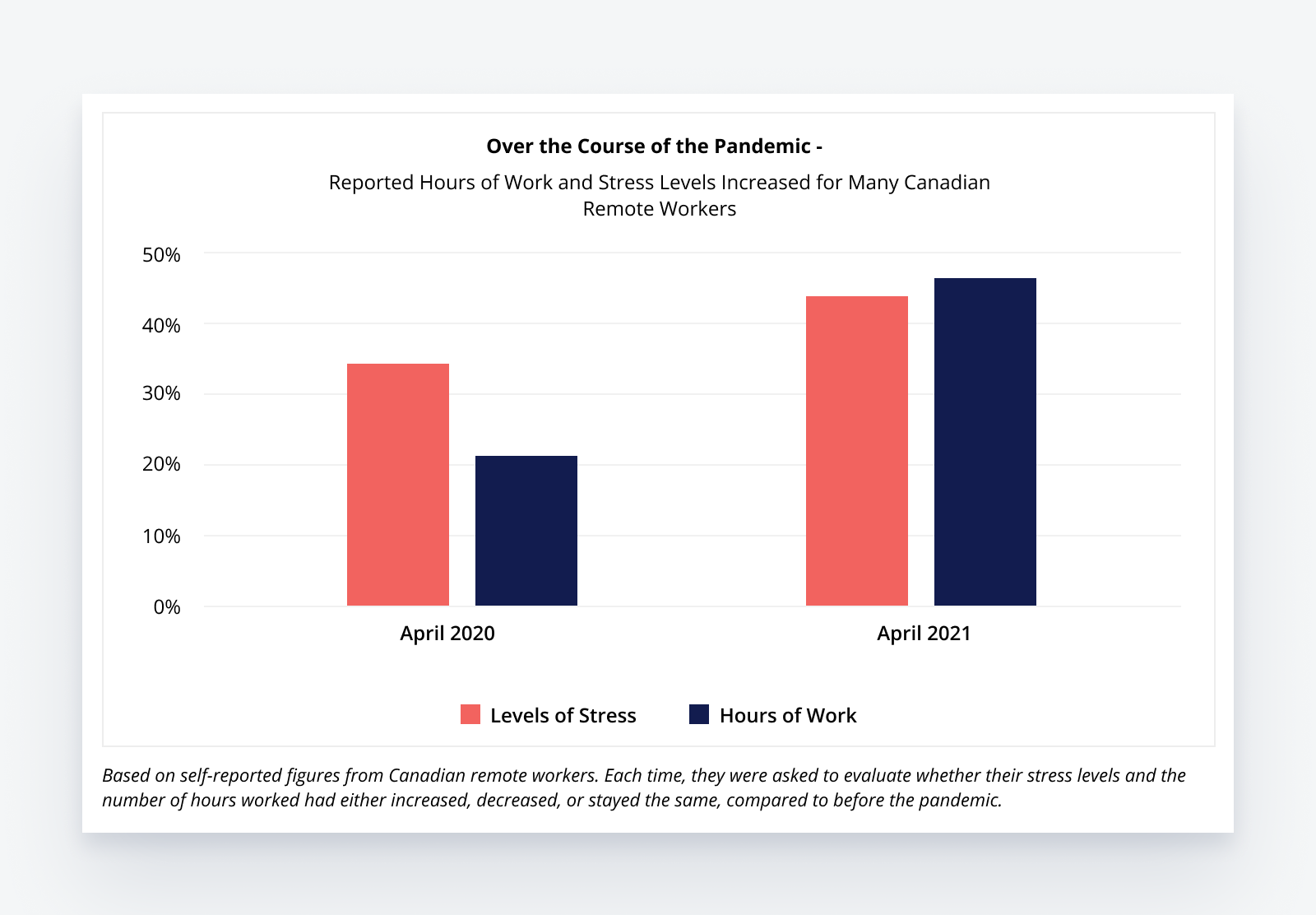
ADP Canada Co.’s Working Canadians are Paying a “COVID Tax”, with Some Reporting Working More than Ever Before (2021)
The same survey found that “stress levels rose 7% over the past year, from 34% in April 2020 to 41% in April 2021.” Similar surveys in the US found that 61% of those surveyed were also experiencing higher levels of stress and were exhibiting signs of burnout.
Disconnect Between Business Leaders and Workers
A recent WHO report outlined several dangerous consequences of overwork, such as a 35% higher stroke risk. Unfortunately, the reality of the situation facing workers is different from that of business leaders.
Microsoft’s 2021 Work Trend Index report published in February showed several troubling findings. Of note, it found that employees were spending substantially more time online, nearly or even doubling for some digital activities.
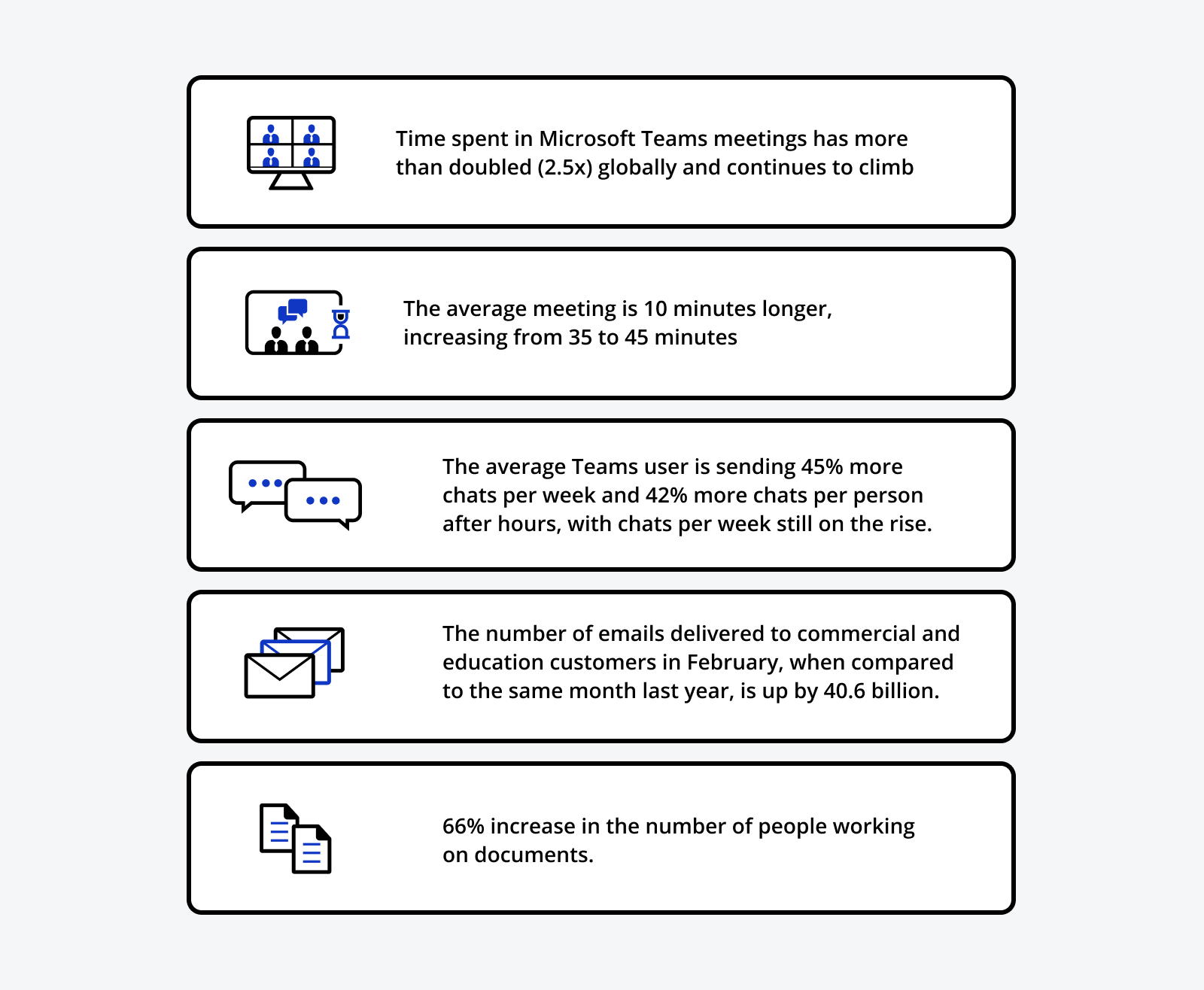
Microsoft’s The Work Trend Index (2021)
A lot of time was wasted in other areas.
For example, 62% of calls and meetings were ad hoc and unscheduled. Despite the bloat in communications, 50% of people responded to Team chats within five minutes or less. This response time has not changed year-over-year, which means that the expectations of employees have dramatically increased.
The report also found that business leaders claimed they were “thriving” — 23 percentage points higher than those without decision-making authority — and that they were “out of touch with employees and need a wake-up call.”
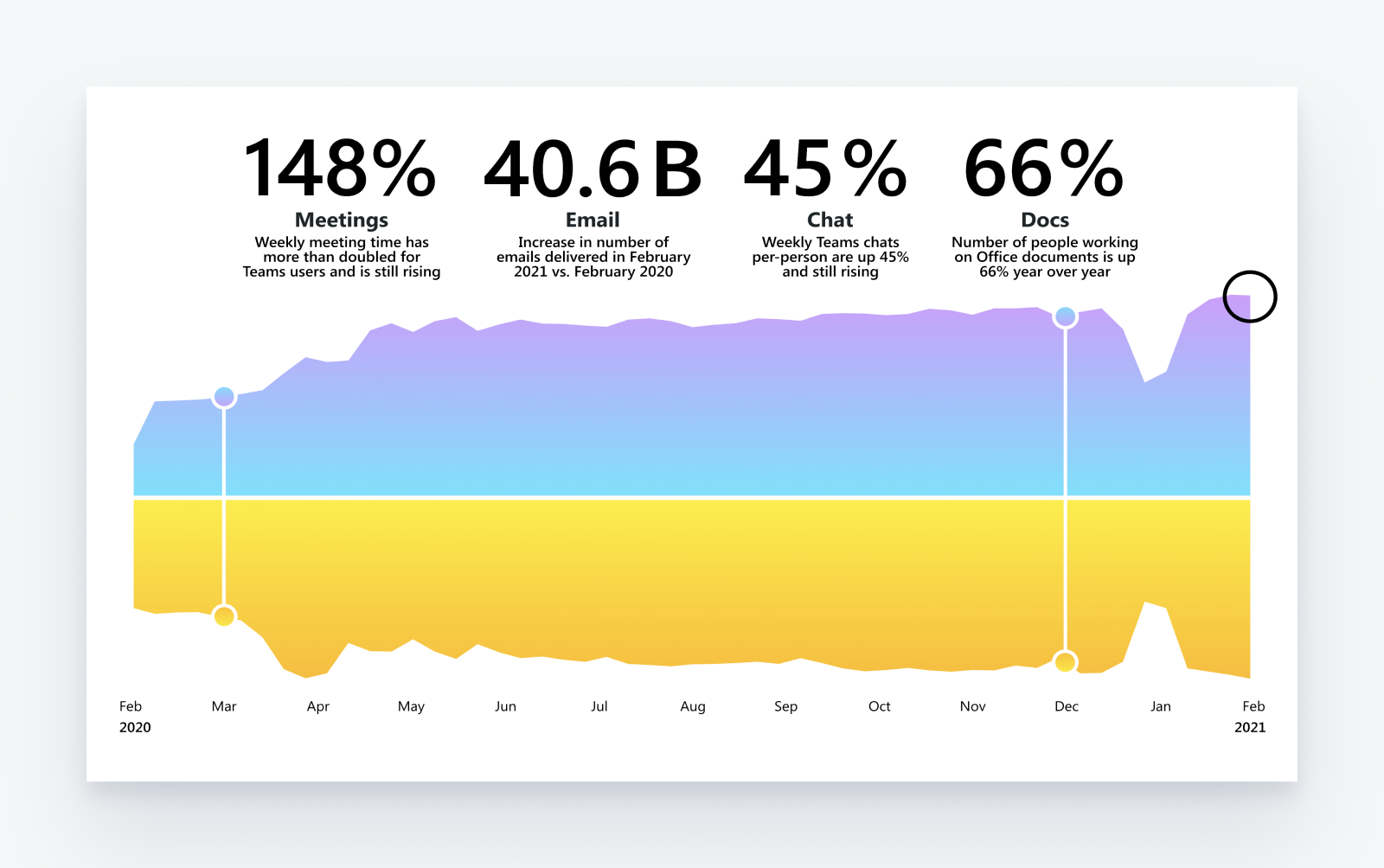
Microsoft’s The Work Trend Index (2021)
The combination of overwork and leaders not understanding their plight has made 41% of employees reconsider their current positions. Unsurprisingly, this coincides with record levels of employee disengagement.
These factors, driven by poor collaboration and inefficient remote-work policies, are leading to an overall productivity decrease of two to three percent for most organizations, reports Bain & Co.
So what happened? How did such a promising push towards greater technology adoption lead to the stagnation most companies are facing today? To find the answer to that and what to expect next, we need to analyze similar trends following the 2008 financial crisis.
The Cycle of Crisis, Optimism, and Pessimism
The trends we’re seeing with the current crisis mirror those that occurred after the 2008 financial crisis.
For example, although overall business growth fell in both situations, sales for technology increased. In the years following the financial crisis, companies everywhere were trying to do the same work or more in an unprecedented global recession. They needed tools to aid in communication and collaboration. It’s why IT is one of the few thriving industries during a time of crisis.
Typically, the most easily accessible and cheapest solutions become the most popular. Last year, it was Zoom. Post-2008, it was email, and it was used for everything.
Email for Everything
Although it was already a communication staple before the crisis, email became relied upon for everything. Meetings, updates, and even project collaboration were now done (or at least attempted) through email because of its low cost and infinite scalability. Little thought was given to how it’d be managed, however.
This lack of foresight led to ongoing issues with email management for many organizations. The biggest strategic gaps were (and continue to be) defining what are “business-critical” emails and formalized training for employees on proper usage.
Problems stemming from these gaps resulted in:
- Employees being unfamiliar with their companies’ email features and capabilities
- Increased ratio of noise to relevant emails (62% vs. 38%) being sent
- Information siloing, as necessary information starts getting lost in the noise
- Breakdowns in interdepartmental communications
- Growing levels of distraction for employees, with it taking on average 2.5 hours to find what they need and 64 seconds to get back to work after checking a new message
- Email itself becoming a symbol of stress
Email Becomes Synonymous with Stress
A 2011 paper published by researchers Barley, Meyerson, and Grodal in Organization Science found that there was a paradox when it came to the impact of email and other technologically enabled communications in people’s lives.
On one hand, technology provides an unparalleled level of flexibility in how and when people communicate. On the other hand, the more time people spend on email, the greater their sense of overload.
The researchers found that the perception of workers to better cope with email overload over time was false. Time spent on email correlated to higher stress, becoming a symbol for that stress itself, and masked true sources of overload in other areas of their lives.
“Contrary to assumptions of prior studies, we found no evidence that time spent working mediates e-mail-related overload…Moreover, by serving as a symbol, e-mail distracted people from recognizing other sources of overload in their work lives.”
As a cultural symbol for overload, email made a convenient scapegoat and shifted the burden to workers, not company policy, to fix.
“As a symbol, email became the interpretive scapegoat for the workers’ perceptions that they were expected to do more than they could reasonably accomplish in a day. It provided them with a culturally sanctioned rhetoric of complaint about overload as well as a tangible ritual for regaining control: to cope with overload, trim your inbox.”
The way email was used blurred the boundaries between work and home spaces, contributing to the association. However, the association was worse or those responsible for caring for children at home or other dependents.
Like communication apps today, the increasing demands of email, teleconferences, and phone use added extra hours to the workday.
The Cost of Poor Digital Communications
Like with the current cycle, there was improved productivity, followed by employee burnout due to lagging strategic elements. By the start of the 2010s, the communication inefficiencies had ballooned into the billions.
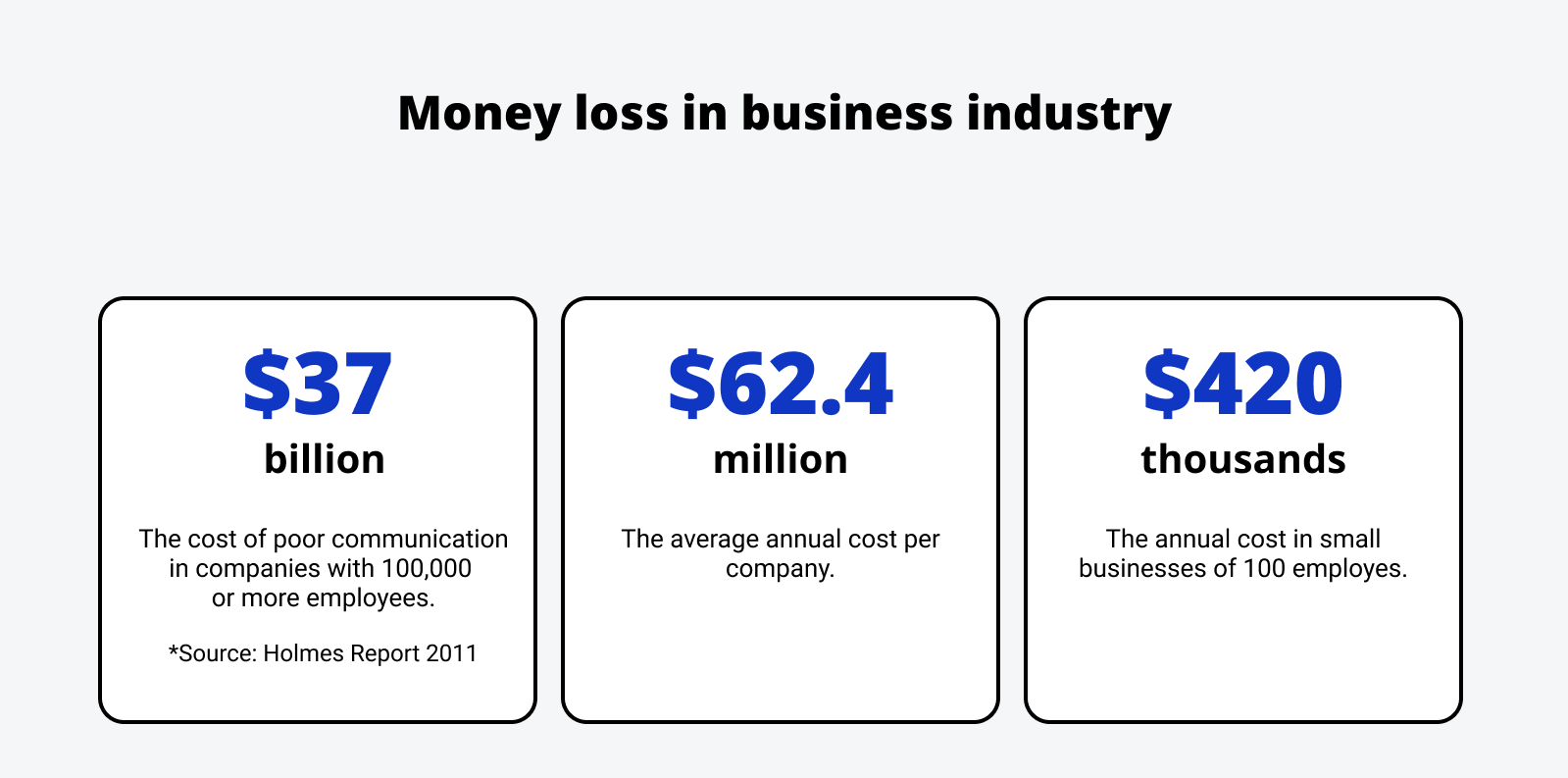
The reason the cost was so high is that communication processes influence critical areas of a business.
Profitability, company culture, and external relationships can all see huge swings depending on how well a company manages its internal communications. Everything from employee motivation and engagement, product knowledge, and project success to overall organizational performance is affected by communications.
“The Problem is Email!” – A Decade’s Worth of Red Herrings
During the mid-2010s, several prominent business leaders and publications claimed email itself was the problem. Some even went so far as to boldly claim they’d reduce or even eliminate email use within their organizations.
For example, former CEO of Atos Origin Thierry Brenton was not a fan of the technology, saying this of it in 2011:
“Email is a very selfish tool. People dump tasks into each other’s inboxes without thinking about whether they are considerate. You become a slave to your inbox checking your email first thing in the morning until you go to bed.”
Brenton claimed that by 2014, email would be entirely eliminated from his international company of 70,000 employees.
Similar attitudes were shared by other business leaders, and the “problem” was tackled in different ways:
- Van Meter decided to ban emails and calls outside of office hours (including booked vacation time).
- Reliable PSD banned email one day of the week except for one hour in the morning and another at the end of the day.
- Get Organized tried to replace email with other communication and collaboration apps.
Of the many examples, several saw some success in countering email overload and improving employee productivity.
However, as shown in the Barley, Meyerson, and Grodal paper, the problem wasn’t the technology but how it was being used. Of course, limiting its use would improve productivity, but an organization with no or a poor digital strategy would be hurt by misusing tools.
Even middle managers who had 100 hours of their year wasted on unimportant emails didn’t want their email access limited or taken away, a 2012 Grossman Group study found.
“We’ve seen companies around the world experimenting with email black-outs or time-outs. However, our research reveals that’s not the most effective approach. We know employees are overloaded by their inboxes and it’s causing them stress, yet our research shows it’s email misbehaviors that need to be addressed…Just as important, leaders must establish guidelines, which are in line with company culture, for how email should be used.”
– David Grossman, founder and CEO of The Grossman Group
Really, the only thing accomplished by most of these companies was damage control. Yes, some KPIs increased, but it left them stagnant compared to competitors who invested resources into comprehensive internal digital communication strategies and policies. These are the companies that were already transitioning their workforces towards more remote work prior to the current pandemic.
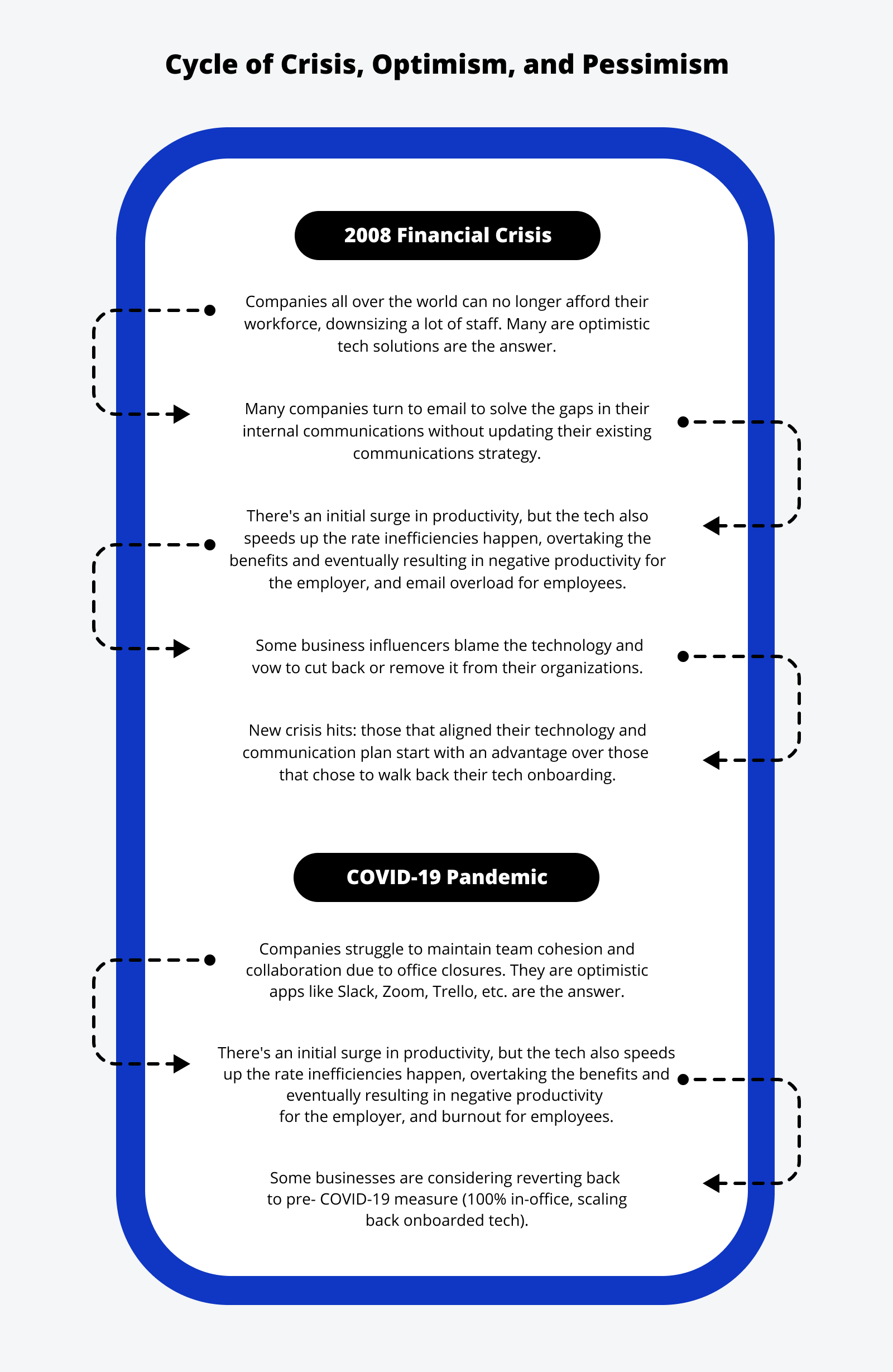
Like today, a corporate productivity gap formed between companies that used the technology well and those that didn’t. The running start some companies have in terms of technology, policies, and strategies today can even be traced back to the lesson they learned then.
Looking Forward, What Should Companies be Doing?
Unfortunately, the speed at which technology and society are moving means that new crises are likely to happen faster in the future. What was a once-in-a-century disruption became a once-in-a-decade. It could now be sooner.
What’s important is having the systems and policies in place to be adaptable.
What we should be learning from the past is that ultimately, no matter how promising the technology is, there’s no replacing having an adaptable and measurable communication and collaboration strategy.
Adopting new technologies will help address sudden market disruptions. But, without the right policies and measures in place, the acceleration of information granted by the tech will accumulate more inefficiencies than efficiencies.
Your workforce will feel these inefficiencies in the form of extended hours and then burnout. Some groups, like working mothers, are disproportionately impacted by it. What this ultimately means for your company is far less employee engagement in the short run and decreasing productivity and then profitability in the long run.
Move Forward, Not Backward
Some parts of the world have started re-opening, and for companies in these regions that are also seeing declining productivity, there’s a temptation to go back to how things were in 2019.
Even ignoring the possibility of another coronavirus wave due to variants, the corporate productivity gap already exists. The companies on top minimized wasted time from excessive emails, meetings, and processes. Turning the clock and abandoning the technology and lessons learned will just re-introduce the barriers to digitization that existed initially.
The gap is already nearing or greater than 50%, allowing these organizations to “out-team, out-innovate, outgrow, and outperform their competitors for many years,” as a Harvard Business Review article puts it. So what you need to do is try to close it.
Re-evaluate Your Internal Communication Strategy
Even prior to the pandemic, most business leaders agreed that internal communications are a connecting thread running through most sectors of an organization. However, there has always been a disconnect between what’s said and what’s done when it comes to communication within many organizations.
Around 60% of companies have no long-term internal communication strategy at all. Even 60% of communication professionals themselves fail to track the effectiveness of communication plans.
How Effective, and Poor Communications Impacts Business
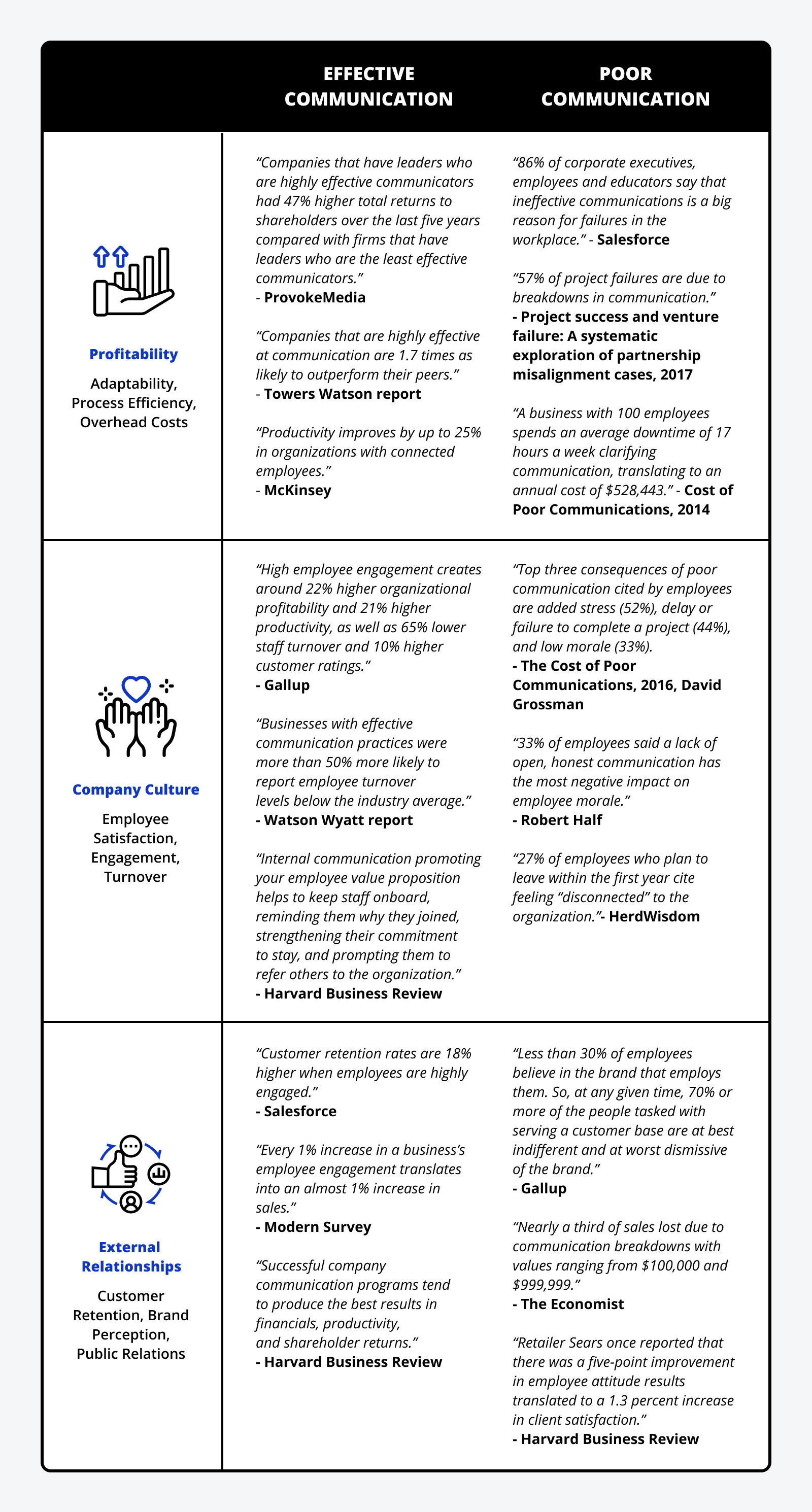
Employees Now Expect Some Amount of WFH
Despite the stigma, remote work had been growing steadily prior to the pandemic. According to a pre-lockdown report from FlexJobs, it was up 159% in the last 12 years. With 60% of the workforce shifting to remote work in the US alone, it’ll be hard for companies to argue that some tasks need in-office workers.
Even among those who wish to return, the majority feel they’ve been more productive working from home than being at their workplace.
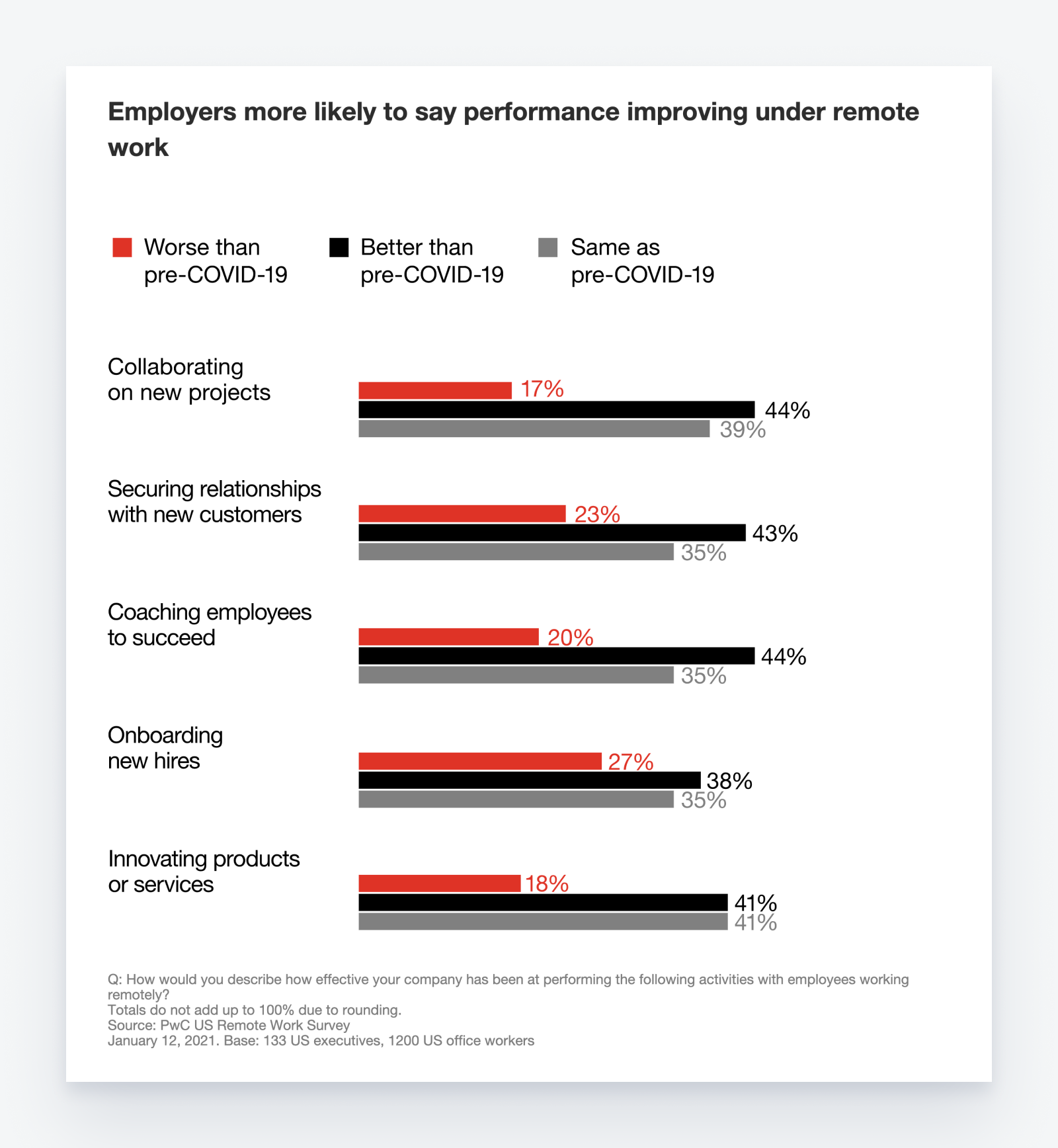
PwC’s US Remote Work Survey (2021)
Even if a company decides a remote or hybrid workplace isn’t for them, it’s likely that their competitors will.
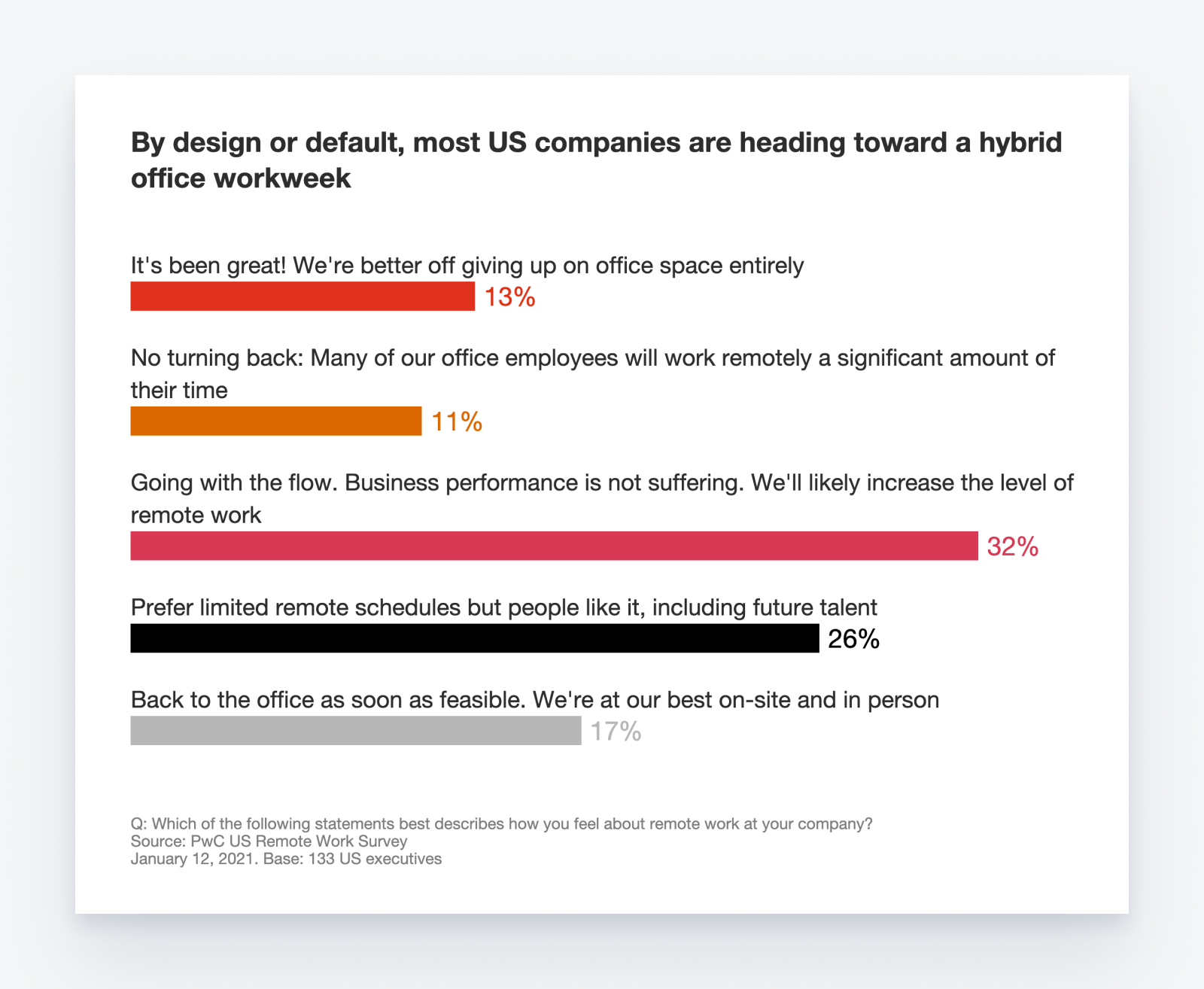
PwC’s US Remote Work Survey (2021)
With two in three people wanting to work remotely after the end of the pandemic, these companies will likely be receiving the majority of candidates. Additionally, a recent survey by LiveCareer found that nearly a third of the working professionals they interviewed would quit if they had to return to the office.
The point is, employees are now aware of how important the flexibility that comes with remote work is, especially women. So, if you do decide to restructure your company back to how it was before Covid-19, be prepared to only have access to a much smaller labor pool.
Understand How Your Employees are Using the New Software
Technology is great at solving problems, but only when it’s part of a bigger strategy.
As we’ve seen in the Microsoft 2021 Index, too many business leaders are only focused on the final output and potential of digital technologies. What they feel and see is disconnected from what their workforce feels and sees.
Similarly, research by Cornell University and Qatalog found that 43% of workers report spending too much time switching between tools. The “uncontrolled adoption” of new software is leading to “productivity apps killing productivity” by “cheating workers out of time, focus, and creativity,” which leads to burnout, the research claims.
By understanding where the inefficiencies lie, you’ll be able to better plan and implement solutions.
According to Eric Garton and Michael Mankins, who wrote the Harvard Business Review article The Pandemic Is Widening a Corporate Productivity Gap, companies need to better manage three elements of their workers to improve productivity:
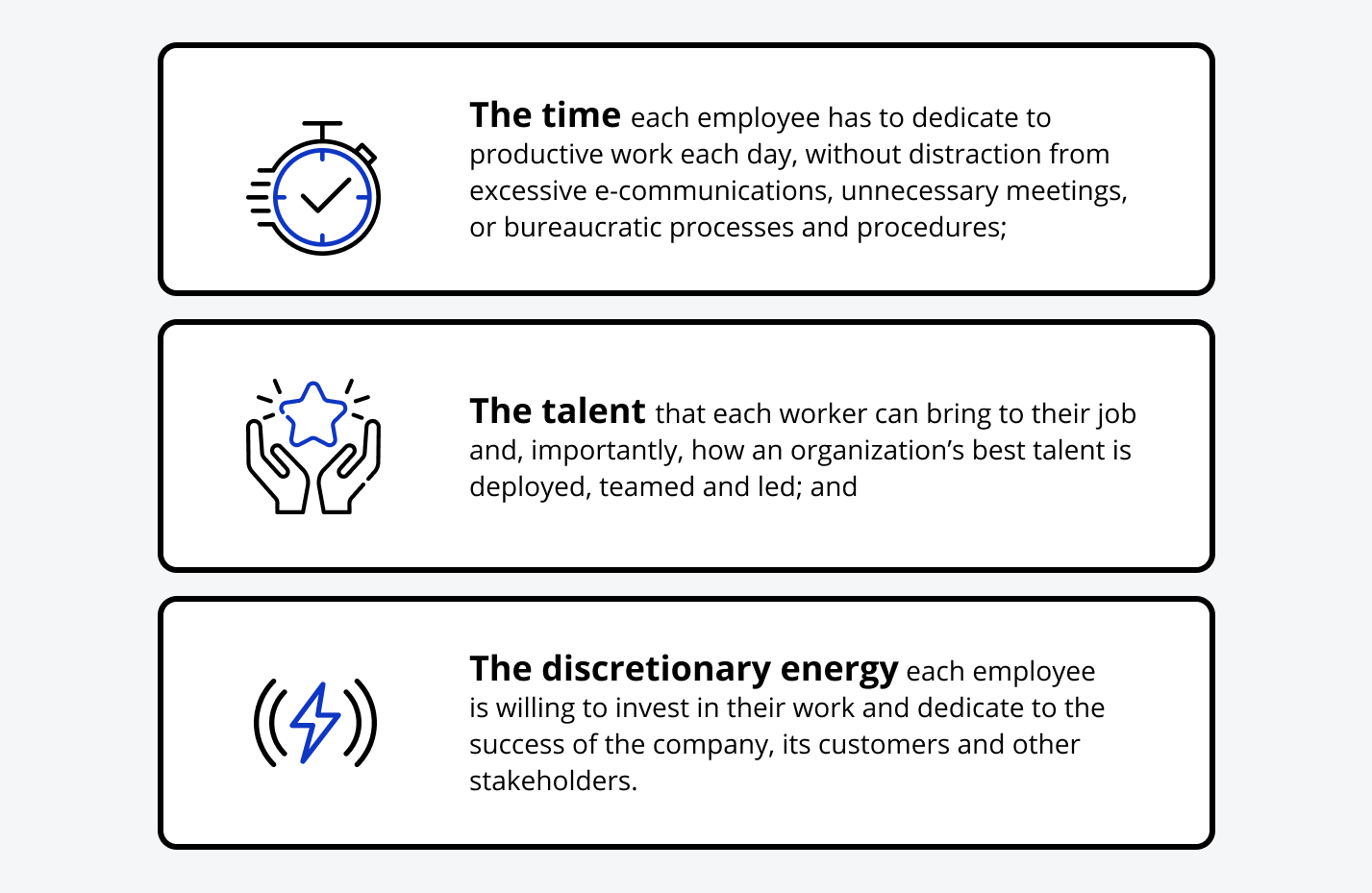
Harvard Business Review, The Pandemic Is Widening a Corporate Productivity Gap (Garton and Mankins 2020)
Although the Covid-19 pandemic and its disruptive effects on the global economy have been novel, the reactions by businesses are not.
In times of crisis, companies turn to technology to help them past the new hurdles. With both the current crisis and the previous one, the main priority has been digitizing communications and collaboration. While in both cases there was an initial spike in productivity, inefficient policies led to growing demands on employees. It’s why, in the years following the 2008 financial crisis, there were so many discussions around “email overload” and why, today, burnout is so heavily discussed.
The difference between companies with efficient communication and collaboration policies that then took on new software versus those that onboarded the software without strong policies in place has expanded an existing corporate productivity gap.
If this crisis continues to follow the pattern of the previous global crisis, many of the latter companies may consider trying to go back to a time before the pandemic. However, all this does is accelerate the speed at which the gap is widening. Instead, business leaders in these companies need to look forward and adapt their communication policies and strategies, align their understanding of the current state of work with their workers, and jump on the new opportunities to come.

Conclusion
Although the Covid-19 pandemic and its disruptive effects on the global economy have been novel, the reactions by businesses are not.
In times of crisis, companies turn to technology to help them past the new hurdles. With both the current crisis and the previous one, the main priority has been digitizing communications and collaboration. While in both cases there was an initial spike in productivity, inefficient policies led to growing demands on employees. It’s why, in the years following the 2008 financial crisis, there were so many discussions around “email overload” and why, today, burnout is so heavily discussed.
The difference between companies with efficient communication and collaboration policies that then took on new software versus those that onboarded the software without strong policies in place has expanded an existing corporate productivity gap.
If this crisis continues to follow the pattern of the previous global crisis, many of the latter companies may consider trying to go back to a time before the pandemic. However, all this does is accelerate the speed at which the gap is widening. Instead, business leaders in these companies need to look forward and adapt their communication policies and strategies, align their understanding of the current state of work with their workers, and jump on the new opportunities to come.
This article originally appeared on getmailbird.com and has been republished with permission.
Business & Finance Articles on Business 2 Community
(47)
